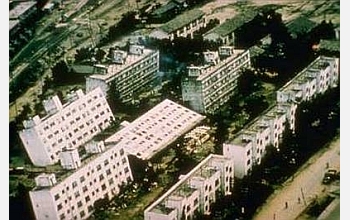News Release 07-027
Scientists Explain Source of Tiny Tremors Emanating from Fault Zones
Tiny non-volcanic earthquakes may indicate dangerous conditions

Entire buildings tilt because of ground failure after the Niigata, Japan, earthquake.
March 15, 2007
This material is available primarily for archival purposes. Telephone numbers or other contact information may be out of date; please see current contact information at media contacts.
Tiny earthquakes called non-volcanic tremors recently discovered in fault zones from California to Japan are generated by slow-moving earthquakes that may foreshadow catastrophic events, according to scientists at Stanford University and the University of Tokyo.
In a study published in the March 15 issue of the journal Nature, seismologists say their findings may be useful in understanding potentially destructive mega-quakes of magnitude 8 or higher. The research was funded by the National Science Foundation (NSF).
"This work gives us a way to use different types of seismic activity to monitor places where large, destructive earthquakes occur," said Eva Zanzerkia, program director in NSF's Division of Earth Sciences.
Gregory Beroza, a geophysicist at Stanford and co-author of the Nature study, said that non-volcanic tremors are often accompanied by low-frequency earthquakes (LFEs)--small quakes of magnitude 1 or 2.
To date, LFEs have been found primarily in subduction zones--seismically active faults where two tectonic plates meet and one plate constantly dives beneath the other. A recent example was the devastating 2004 earthquake near Sumatra, where a magnitude 9.2 quake triggered powerful tsunamis that killed more than 200,000 people.
Recent studies suggest that these giant quakes, which form at relatively shallow depths, are preceded by a series of much deeper events called slow (or silent) earthquakes, which displace the ground without shaking it. A slow earthquake can last days, months or years without being felt at the surface.
But detecting slow quakes is a difficult task, Beroza said. That's one reason why seismologists were particularly excited by the recent discovery of LFEs in the subduction zone near Shikoku, Japan.
The insight may open new avenues of research for predicting earthquake hazards by using LFEs as indictors, said David Shelly, also a Stanford scientist. "This could lead to an improved ability to forecast a major earthquake in these regions."
Seismologist Satoshi Ide of the University of Tokyo is the third co-author on the Nature study.
-NSF-
Media Contacts
Cheryl Dybas, NSF, (703) 292-7734, email: cdybas@nsf.gov
Mark Schwartz, Stanford University, (650) 723-9296, email: mshwartz@stanford.edu
The U.S. National Science Foundation propels the nation forward by advancing fundamental research in all fields of science and engineering. NSF supports research and people by providing facilities, instruments and funding to support their ingenuity and sustain the U.S. as a global leader in research and innovation. With a fiscal year 2023 budget of $9.5 billion, NSF funds reach all 50 states through grants to nearly 2,000 colleges, universities and institutions. Each year, NSF receives more than 40,000 competitive proposals and makes about 11,000 new awards. Those awards include support for cooperative research with industry, Arctic and Antarctic research and operations, and U.S. participation in international scientific efforts.
Connect with us online
NSF website: nsf.gov
NSF News: nsf.gov/news
For News Media: nsf.gov/news/newsroom
Statistics: nsf.gov/statistics/
Awards database: nsf.gov/awardsearch/
Follow us on social
Twitter: twitter.com/NSF
Facebook: facebook.com/US.NSF
Instagram: instagram.com/nsfgov


